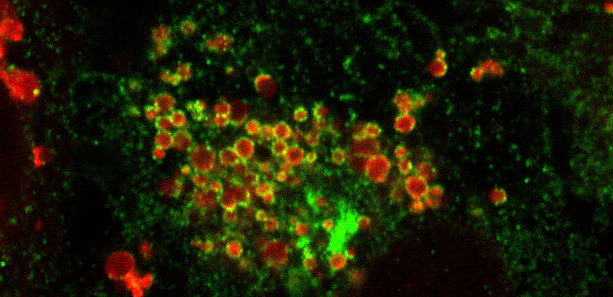
Inside of a human cell during oxidative stress; the mitochondria are labeled by a chemical dye (red) and the protein Rab5 is expressing a green fluorescent tag (green). The image shows Rab5 forming a ring-like structure around mitochondria. © FoSheng Hsu / MPI-CBG
The inside of a human cell is divided into compartments called organelles, which are surrounded by membranes. Each organelle plays a specific role in keeping the cell healthy and also has a unique mix of molecular markers on its surface. These markers allow other molecules to identify the different organelles. Specific organelles can communicate with each other and coordinate their activities. However, how information is relayed between organelles was largely unknown. To tackle this question, FoSheng Hsu, a postdoctoral researcher in the lab of MPI-CBG director Marino Zerial, and his colleagues embarked on an exploration delving into inter-organelle communication. Surprisingly, they discovered a physical connection between the two cell organelles, mitochondria and endosomes, which occurs when cells experience high levels of oxidative stress – a condition by which the levels of toxic chemicals called reactive oxygen species become too high. These results are published in the open-access journal eLife.
Mitochondria are organelles that not only provide energy inside human cells, but also work to keep the levels of oxidative stress in check. The surprising finding that endosomes, which are responsible for sorting materials within the cell, can physically interact with mitochondria led the international team of researchers from the Hyman and Zerial lab at MPI-CBG and the Parton lab at the University of Queensland in Australia to further investigate the physiological relevance of this phenomenon.
In many neurodegenerative diseases, mitochondria and endosomes in neurons do not work properly. Interestingly, these cells also have levels of oxidative stress that are higher than normal. The researchers used human stem cells, grown in culture, and induced them to become neurons. The team then discovered that the protein ALS2/Alsin, previously shown to be mutated in a juvenile form of amyotrophic lateral sclerosis (ALS), is targeted to the surface of mitochondria upon oxidative stress. Furthermore, ALS2/Alsin functions as a vehicle to bring a protein called Rab5, usually found on endosomes, to mitochondria. This stress response turns out to be a critical determinant of life or death for the neurons.
Future experiments are now warranted to explore whether defects in endosomes or mitochondria, and specifically with molecules like ALS2/Alsin and Rab5, are responsible for other neurodegenerative disorders like Parkinson’s disease and Huntington’s disease.
FoSheng Hsu, Stephanie Spannl, Charles Ferguson, Anthony A Hyman, Robert G Parton, Marino Zerial: Rab5 and Alsin regulate stress-activated cytoprotective signaling on mitochondria, eLife, 22 February 2018